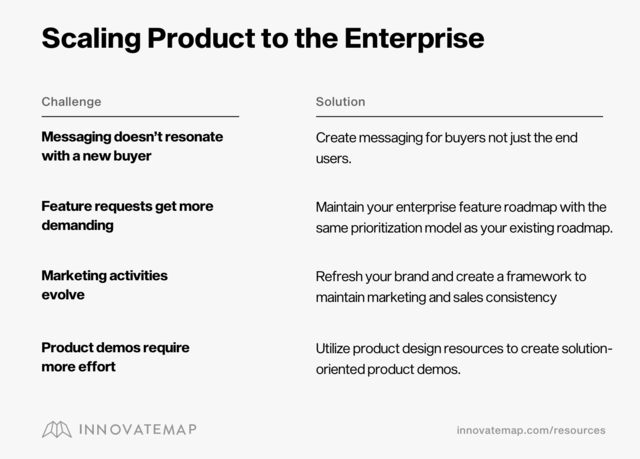
4 Product Challenges to Overcome When Scaling to the Enterprise Market
If you’re not targeting enterprise initially, many B2B SaaS companies (if they’re successful) will eventually move up-tier to larger companies. It’s only natural since the margins and revenue are undeniably attractive as you increase the average contract value.
But this isn’t an article about sales, it’s about product. First, before we get to scaling for the enterprise, let’s set the context as to how a product finds product/market fit. Once you get your first customers, you have to experiment with messaging, brand, and product features as you find who your best customers are, and which aren’t so great. And if you’ve set up your product well then you’ve likely designed for growth, established a strong messaging framework, and created a scaleable brand.
But once you make the shift to the enterprise, a lot of these decisions and frameworks get tested. Climbing the proverbial ladder to larger customers creates new challenges for product that can catch many founders by surprise:
1. Messaging doesn’t resonate with a new buyer.
2. Feature requests get more demanding.
3. Marketing activities evolve.
4. Product demos require more effort.
Let’s take a look at the ways to overcome these challenges.
Challenge 1: Messaging doesn’t resonate with a new buyer
For many founders, the initial vision is driven by personal experience. This allows many startups to succeed based on an inherent ability to connect with customers experiencing the same pains. But in the enterprise, you’re likely dealing with new buyers that don’t personally experience those pains, or don’t even know there are pains to be solved. As a result, all that great messaging you’ve been honing for several years starts to fall flat with managers, VPs, or C-Suite.
Now, as you prepare to scale you won’t know exactly how the messaging should change. That’s why you should look at your messaging with fresh eyes and experiment. What resonates with different roles? What roles are more receptive to your message? You will start to find not only what messaging works, but which prospects are even good fits for your product. The hard truth is that in some cases you may have total fit with end users but certain organizations make it nearly impossible to penetrate.
At the core, going after the enterprise market requires a similar product marketing exercise as your first two years. Don’t expect your existing messaging to resonate, and be prepared to enable your marketing and sales team to become agile.
Takeaway: Research and internalize the needs, pains and wants of your new buyers and create messaging that connects with them.
Challenge 2: Feature requests get more demanding
Before SaaS, most software was built custom per client. While development models have changed, the needs of large companies have not. They have very specific needs and the money to make it happen.
But you’ll have to tread carefully. You can easily start getting excited by the potential revenue while abandoning core principles. If left unchecked, even the leanest, most well-designed products can succumb to feature bloat. And worse, enterprise needs can negatively impact your core users.
To avoid feature bloat, you need feature focus.
First, figure out your plan for your product hierarchy. Do you want to create new products based on customer size? New features? Or can you handle it with brand hierarchy? Can you create features generically enough that they can be utilized by other enterprises? The first answer to maintaining a mature product’s focus is to start with how new markets can be addressed without actually creating new products. You may have only had one product or brand to maintain up until this point, so be prepared to think how you’d scale that while staying true to the original vision.
Second, think through how your product development team will be structured. You may have PMs that are great at maintaining features but you need more help spinning up new features. How will you structure your development and design efforts between new features and core product maintenance? Lay out your product team growth and needs before making promises so you can ensure that signing new enterprise accounts won’t negatively impact your product growth or existing users.
Takeaway: Maintain your enterprise feature roadmap with the same prioritization model as your existing roadmap.
Challenge 3: Marketing activities evolve
If you’re at a healthy ARR, you’ve likely already experienced some of this. You likely had to expand your brand from a logo on a business card and a Squarespace site to a robust CMS-oriented site with brand aligning to digital marketing efforts. But enterprise is a curveball; one that usually tricks people into thinking they have to change everything about their brand. Truthfully, you will have to make some adjustments, but not necessarily in the ways you’d expect.
First of all, you’ll need to grow up. While this doesn’t mean that you can’t keep your personality infused into your brand, it does mean that you need to ensure your brand is consistent.
When it comes to the enterprise, the brand that got you here won’t get you there.
Secondly, your brand touchpoints will increase. You may be heading to more trade shows, or you may have tripled your sales team. In either case, when you move into the enterprise you should start planning ahead for how your marketing activities will change, what you’re going to add, and what new roles will be entrusted with your brand. Plan your brand refresh around these efforts to ensure you’re carrying forward the right story, consistently.
Takeaway: Refresh your brand and create a framework to maintain marketing and sales consistency.
Challenge 4: Product demos require more effort
As companies get larger, the silos increase and teams don’t talk as much. Additionally, sales cycles get longer and sales teams grow. You used to be able to be join sales calls yourself, but you now don’t always know what sales activity is happening, and worse, what’s getting promised. When you prepare to scale upstream, you can combat this by ensuring that not only is your product team aligned with sales and marketing, but so is your design team.
Once a product is succeeding in market, product design shifts to UX design; from being highly focused on new features to maintaining and tweaking existing ones. But when your sales team is trying to get a large client, they’ll need some of that old-fashioned innovation. Rather than worry about your sales team making pie-in-the-sky promises that can’t be delivered, ensure that your sales team views UX and product design as a resource to paint compelling and feasible visions, while also doing so in a way that won’t create a Frankstein’s monster of a product.
Takeaway: Utilize product design resources to create solution-oriented product demos.

Having the opportunity to scale your product to enterprises is a mini-victory in and of itself. It usually means you’ve been successful in building something valuable and now you’re ready to share it with larger companies. But this leap is one that can come with its own set of challenges. The answer to how you overcome these challenges changes from case to case, but I hope this has helped expand your horizon on what to look for and how to prepare your product for enterprise scale.



